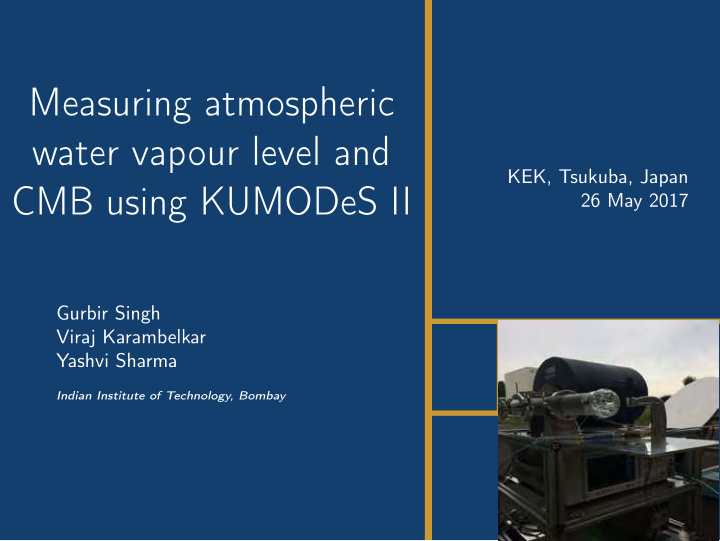



Measuring atmospheric water vapour level and KEK, Tsukuba, Japan CMB using KUMODeS II 26 May 2017 Gurbir Singh Viraj Karambelkar Yashvi Sharma Indian Institute of Technology, Bombay
1 Introduction KUMODeS II Theory Model LMFit 2 Observations 3 CMB
Introduction images/IM_logo.pdf Schematic Diagram of KUMODeS II
Introduction images/IM_logo.pdf KUMODeS II Using KUMODeS II, we measured ◮ Precipitable Water Vapour (PWV)
Introduction images/IM_logo.pdf KUMODeS II Using KUMODeS II, we measured ◮ Precipitable Water Vapour (PWV) ◮ Cosmic Microwave Background (CMB)
Introduction images/IM_logo.pdf Theory ◮ Nyquist Theorem P = kGBT
Introduction images/IM_logo.pdf Theory ◮ Nyquist Theorem P = kGBT ◮ Y factor method P hot = kGB ( T noise + 300 ) P cold = kGB ( T noise + 77 )
Introduction images/IM_logo.pdf Theory ◮ Nyquist Theorem P = kGBT ◮ Y factor method P hot = kGB ( T noise + 300 ) P cold = kGB ( T noise + 77 ) ◮ Sky Observation � � P sky = kGB T noise + T sky
Introduction images/IM_logo.pdf Model Used AM to model the atmospheric emission
Introduction images/IM_logo.pdf LMFit AM + mx + c � �� � Oxygen + CMB
Introduction images/IM_logo.pdf LMFit AM + mx + c � �� � Oxygen + CMB ◮ The parameters were PWV, m, and c.
Introduction images/IM_logo.pdf LMFit AM + mx + c � �� � Oxygen + CMB ◮ The parameters were PWV, m, and c. ◮ The data was fit according to this model using LMFit
Observations images/IM_logo.pdf First run The noise temperature observed was
Observations images/IM_logo.pdf Improvement By replacing a cable, we were able to improve the noise temperature. Figure:
Observations images/IM_logo.pdf Improvement By installing an isolator, the noise temperature was further improved. Figure: Block diagram with isolator
Observations images/IM_logo.pdf Improvement Figure: Comparison of noise with and without isolator
Observations images/IM_logo.pdf Sky Observations
Observations images/IM_logo.pdf PWV fit
CMB Measurement
CMB images/IM_logo.pdf CMB Measurement using KUMODeS II setup When the sky is observed using the radio receiver, ◮ 1 P out = kGB ( T noise + T atm × cos ( z ) + T cmb ) z : zenith angle
CMB images/IM_logo.pdf CMB Measurement using KUMODeS II setup When the sky is observed using the radio receiver, ◮ 1 P out = kGB ( T noise + T atm × cos ( z ) + T cmb ) z : zenith angle Also, from the Y-Factor method,
CMB images/IM_logo.pdf CMB Measurement using KUMODeS II setup When the sky is observed using the radio receiver, ◮ 1 P out = kGB ( T noise + T atm × cos ( z ) + T cmb ) z : zenith angle Also, from the Y-Factor method, ◮ P hot = kGB ( T noise + 300 )
CMB images/IM_logo.pdf CMB Measurement using KUMODeS II setup When the sky is observed using the radio receiver, ◮ 1 P out = kGB ( T noise + T atm × cos ( z ) + T cmb ) z : zenith angle Also, from the Y-Factor method, ◮ P hot = kGB ( T noise + 300 ) ◮ 1 P out − P hot = kGB ( T atm × cos ( z ) + T cmb − 300 )
CMB images/IM_logo.pdf CMB Measurement using KUMODeS II setup When the sky is observed using the radio receiver, ◮ 1 P out = kGB ( T noise + T atm × cos ( z ) + T cmb ) z : zenith angle Also, from the Y-Factor method, ◮ P hot = kGB ( T noise + 300 ) ◮ 1 P out − P hot = kGB ( T atm × cos ( z ) + T cmb − 300 ) A plot of (Pout-Phot)/kGB vs sec(z) is a straight line with intercept (T cmb − 300 )
CMB images/IM_logo.pdf Observations Figure: CMB
CMB images/IM_logo.pdf Results We obtained the cmb temperature spectrum as Figure: CMB temperature vs frequency
CMB images/IM_logo.pdf Conclusions The cmb result is off from the expected value of 2.7K This is probably because of the following reasons- ◮ Reflections from the mirror and ground When we plot Tsky vs Frequency, we observe a trend that the sky temperatures increase with time. Also, a standing wave pattern (wavelength 1m approx) is seen in the sky temperatures taken at later times. However, no such increase in temperatures are seen in readings taken inside the building during noise calculations.
CMB images/IM_logo.pdf Conclusions The cmb result is off from the expected value of 2.7K This is probably because of the following reasons- ◮ Reflections from the mirror and ground When we plot Tsky vs Frequency, we observe a trend that the sky temperatures increase with time. Also, a standing wave pattern (wavelength 1m approx) is seen in the sky temperatures taken at later times. However, no such increase in temperatures are seen in readings taken inside the building during noise calculations. Hence, the increase is probably due to reflections from the mirror used to focus the radiation and ground.
CMB images/IM_logo.pdf Conclusions Figure: Sky Temperatures
CMB images/IM_logo.pdf Conclusions
CMB images/IM_logo.pdf Conclusion Uncertainty in gain of Amplifier ◮ We have calibrated the gain of the receiver by taking two Y-Factor measurements, before and after the sky measurements. Then, we used linear extrapolation to find the gain of the amplifier during measurement time.
CMB images/IM_logo.pdf Conclusion Uncertainty in gain of Amplifier ◮ We have calibrated the gain of the receiver by taking two Y-Factor measurements, before and after the sky measurements. Then, we used linear extrapolation to find the gain of the amplifier during measurement time. ◮ However the gain of the amplifier is extremely sensitive to temperature, and the gain profile may not be linear. In other telescopes, and even KUMODeS, real time gain calibration is done using a cold body inside the telescope.
Thank You!
Recommend
More recommend